You are reading the older HTML site
Positive Feedback ISSUE
september/october 2008
Audio Ramblings - My Journey Continues: Computer Based
Audio, Part 2
by Dave Clark

In last month's Rambling's I wrote about my initial experiences with computer based audio. Lots to learn and lots to try. This month I would like to expand on these experiences—especially with respect to USB convertors and such.
As you might recall I decided to settle on a Mac Book to run the system, along with a NAS set up as a Raid 5; easy and rather fool-proof, especially with iTunes handling the ripping and playback. To get the bits to the Cary 306 Professional I latched onto several convertors: the Swiss Army of controllers Pop Pulse PC Link II (based on the CM-108 USB audio I/O controller that allows for optical, USB, and S/PDIF in and S/PDIF, BNC, and AES/EBU digital outs at 16/44.1 or 24/96kHz - $129.95 from Cryo-Parts.com), the Hagerman HagUsb (based on PCM2704 USB audio I/O controller and outputs S/PDIF at 16 bits/32kHz, 44.1kHz, or 48kHz - $105 from Hagerman himself), the Trends UD 10.1 Lite (also based on the CM-108 USB audio I/O controller allowing for USB in and S/PDIF, BNC, and AES/EBU digital outs but only at 16/44.1 - $169.95 from Audio Magus), the Empirical Audio Off-Ramp Turbo 2 (based on the TAS1020B USB audio I/O controller with a USB in and S/PDIF output at 16/44.1 or 24/96 kHz - $990 from Empirical Audio), and the Empirical Audio Pace Car re-clocker (with optical in and AES/EBU digital out at 16/44.1 - $1600 as configured). No doubt this is not the complete listing of what is available, but it does serve as a decent list of what is out there are various price points.
Now what is really cool is that the Mac Book allows for either USB or optical out to whatever your heart desires. Choosing either is simply done by changing the output in the Utilities folder under Midi. One can also easily set the bit-rate as well. The Trends, Pop Pulse, and Hagerman only will take 16 bits, the Pace Car will accept 16 or 24 bits, and the Off-Ramp will accept only 24 bits. I should note that the Pace Car can be configured to accept 24 bits (96kHz) when a second clock is added to its circuit. This raises the price to around $2200. It should be noted that in either configuration of the Pace Car, one needs to send Steve their computer so that the Pace Car can be slaved to the PCU's clock.
Of course with these various convertors one is faced with either USB and/or optical in (along with different USB and optical cables), S/PDIF and/or AES/EBU digital out (along with different S/PDIF and AES/EBU digital cables), 12 volt wall-wart or battery supply… yikes! Lot's to do… so I guess it boils down to this…

Was there a difference between the various convertors?
Well… yeah. First off let me say that they all work quite well and for the most part any significant sonic differences tend to be more a reflection of resolution and what that can bring to the table. That is they all "sound" tonally very much alike when they are on even ground—sort of like comparing apples to apples. That is, whenever possible, I set them all to 16 bits (not the Off-Ramp) and used the same USB and S/PDIF or AES/EBU digital cables. This allowed to me compare them on relatively even footing. As such any of the boxes are a winner, in that they all worked and sounded quite nice. One would be hard pressed to find any faults when used on their own as differences (or faults that would lead one to prefer one unit over another) only appeared when they were swapped out one after another—like I did. Done this way, yeah differences are audible with respect to tonal decay and spatial presentations (depth, width, and that 3D palpable presence), and naturalness as a result of harmonic integrity.
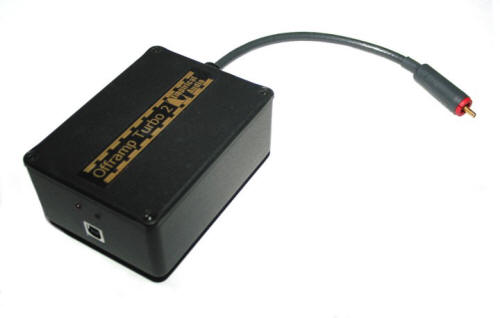
As such the two Empirical units easily distanced themselves from the others. Case in point, Lambchop's "The Daily Growl" from Is A Woman. This track starts with a nicely mic'ed piano that the two Empirical units presented as being more real and natural than the other convertors. Nice harmonics and attacks… the piano sounded more "right" when compared directly against either the Pop Pulse, Hagerman, or Trends, where the piano sounded clangy and thin. This track also features tons of ambiance and spatial presence and yeah, here the two Empirical units distanced themselves from the others as well. While the Pop Pulse, Hagerman, or Trends presented a tight oval-like soundfield between the two speakers, the two Empirical units did so in a much larger oval that extended well beyond the outside of each speaker.
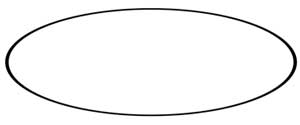
Soundfield with the Hagerman, Pop Pulse, and Trends
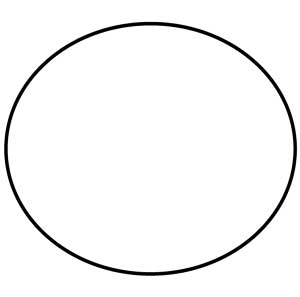
Soundfield with the Empirical units
Also there is a bell off the left that is struck once. Via the two Empirical units the decay is much longer and more real—more of a dinnnnnnnnnng versus a dinnng. No doubt all of this is a result of increased resolution by means of WAY lower jitter and a superior implementation of how the input is converted to the output.
And yeah, the Pace Car does better than the Off-Ramp in the same ways that they both better the other convertors, though in absolute terms the differences are much narrower between the two than between them and the rest. The Pace Car is simply stellar at getting the music out into the room in a way that equals that heard from spinning CDs directly with either the Cary or the EMM. In the previous Ramblings I reported that what I was hearing via computer was not really equal to that from either player… different for sure, and while it was good, it was simply not as good (this was based on using the Off-Ramp with a generic USB cable). Well… with the Pace Car and computer rig set-up just right (see below) it is as equally engaging as the other sources in the system. Still different mind you, but wow does it sound good! The Off-Ramp is a close second where it looses out in terms of ultimate resolution—though only when compared directly to the Pace Car. When used with the Locus Design Axis USB it is very nice indeed and is a very close second. Both Empirical units are harmonically rich, dynamic as all get out, and naturally detailed without a hint of glare or grit. Not hyped in the least… music is oh so sweet and naturally real. But, as its name implies, the Pace Car clearly leads the pack.
Was there a difference between USB or optical in? And was there a difference between the various USB or optical cables?
There should be simply in terms of how using an optical connection would remove any electrical noise being passed along the connection between the Mac and any of the convertors as opposed to USB which is, well… perhaps not the best choice based on how it is implemented in the PC. That is USB has potential flaws that must be addressed to sound its best… and no doubt this will also apply to Toslink. Even so, yeah, optical did sound quite good—rich and natural, especially when using the Van den Hul Optocoupler MKII ($110, courtesy of Eugene Hi Fi). But depending on the interface cable these differences became subtle and where more dependent on the actual convertor being used at the time.
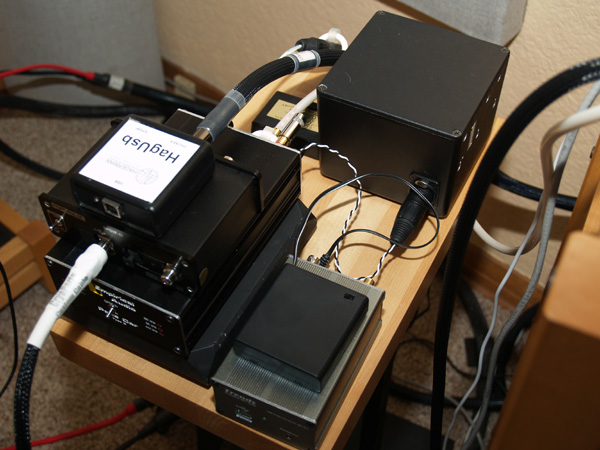
Meaning that yes, comparing Optocoupler MKII to that of a generic (yet decent) Toslink cable reveals that the Optocoupler does offer better sonics. Why? Got me… just passing the bits along, though perhaps it is doing a better job of it with less hassle. Don't know. But the Optocoupler MKII audibly offers greater presence, dimensional palpability, harmonic rightness, etc. All those things we associate with higher levels of resolution and having the right information at the right time, though the Optocoupler MKII does this without going over the top. That is, the Optocoupler MKII is not brash or bright… no grit or glare. Just sweet music that is not euphonically overly colored and possessing of proper delicates that are oh so delicate. It simply sounds quite right. Of course there are those who will bash Toslink as being crap, but well… as I noted it sounds quite wonderful here—I found nothing to complain about.
On the other hand, I also had several USB cables here (generic stock - $10.95, Locus Design Axis - $459 built from the bottom up to be monster, Cryo-Parts $69.95 modified stock USB cable, Kimber - $65) and yes they do make a difference as well, and in many ways a greater one than realized from that of the better Toslinks. Simply put the better the USB cable the better things sounded—almost on equal to that heard with the Optocoupler MKII on the Pace Car. Using the Locus Design Axis on the Off-Ramp showed that one could get it mighty close, especially in terms of harmonic rightness and overall musicality (yeah, still lacks the last bit of resolution and such) to that of the Pace Car when used with the Optocoupler MKII. The Locus Design Axis is something to write home about. Mating it to any of the convertors, especially the Off-Ramp, allowed them to really strut their stuff. This cable was a great equalizer and while it is a bit over the top to use a cable that sells for several times the price of the convertor, it is highly recommended just the same. Hey the other two are very good as well (either the Cryo-Parts or Kimber USB cables), but they simply are not in the same league as the Axis. This cable will get you all that the optical has to offer… no trade-offs or concessions here.
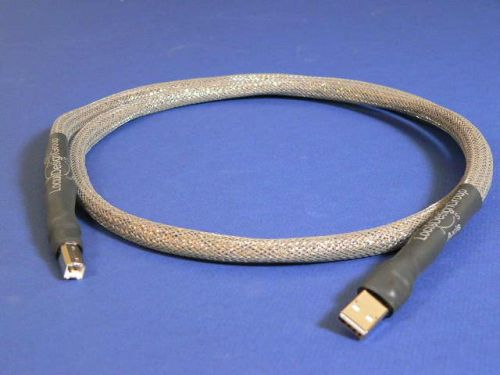
So yes, Toslink cable can sound quite right. Is it a matter of isolating the computer from the DAC (a better means of transferring data) or simply using optics as opposed to wires? Don't know, but when a USB cable that was constructed with the specific purpose of transmitting "audio" is used …well things get better really fast. Yeah, better cables sound better. But a better optical connection sounds better than better wire connection.
Was there a difference between S/PDIF and/or AES/EBU digital outs? And was there a difference between the various S/PDIF and/or AES/EBU cables?
Since the Cary 306 Professional has both S/PDIF and/or AES/EBU digital inputs and the Pop Pulse and Trends allow for either as well, this was an easy comparison. Unfortunately the Pace Car only allows for AES/EBU and the Off-Ramp S/PDIF so that is how they were used (though when comparing either of them to the other two units I was able to use the Pop Pulse and Trends with the appropriate output making it apples to apples).
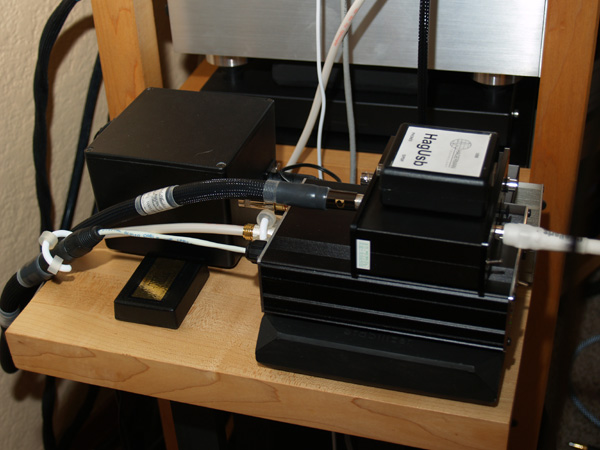
Differences were subtle, though I did prefer AES/EBU over S/PDIF. The presentation seemed just that much quieter and relaxed while being dimensionally bigger with a bit more dynamic slam and presence. This was realized using the same cable—1-meter runs of Purist Audio Aqueous Anniversary in both 75-ohm RCA ($650) and 110-ohm AES/EBU ($750). That way it was apples to apples (same as the rest of the system(also PAD), just a different implementation. I could easily live with either, but since the system is balanced (players to preamp to amps) might as well keep it that way …even with the computer set-up.
Other cables in house were the DH Labs D-110 AES/EBU cable ($89), Blue Jean (Belden 1694A - $15), Moon Audio Black Dragon ($170), Canare Digiflex Gold 2 ($40), and a Signal Cable (also I believe based on the Belden 1694A - $30).
The DH Labs was very competitive against the PAD where differences were more of tonality and overall presentation. The PAD was a bit darker, lusher, warmer, more dimensional …but nothing to make me want to use one over the other. More a matter of taste or system balance than anything else—different flavors. For example, the DH was a bit more transparent and detailed (resolving?) which was no doubt reflective of it being more tonally even. Dark it is not, but nor is it lean or bright. I would say evenly balanced with little to complain about … and at $89! What a steal!
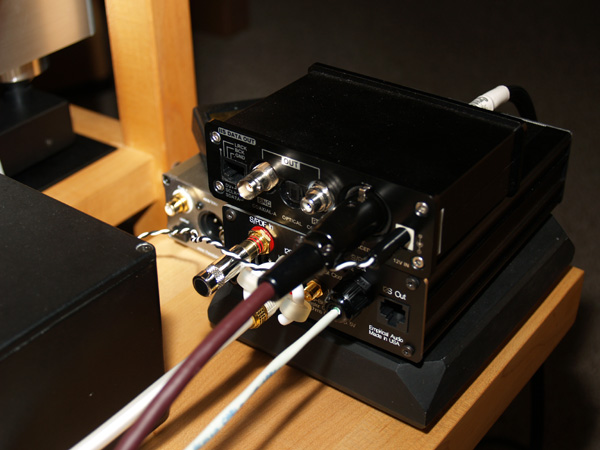
With respect to the other cables… the Moon Audio was a clear winner when compared against the Belden based cables and could run with the D-110 from DH Labs sonically, in that it shares many of the same attributes as I have noted above; tonally well-balanced, musically transparent and resolving while never going over the top… highly recommended. The others are fine but lack many of the better cables' qualities that set them apart. They are slightly more colored while being less resolving; they present a fine grain or etch to the sonic fabric, and well… simply do not sound as good. Not that they sound bad, they simply are not as good in terms of my overall musical enjoyment.
Is there a difference between running on DC (battery) or via the wall (also DC but via the supplied wall-wart)?
This was interesting as I decided to run all the power supplies from a strip that was plugged into the Audio Magic Transcendence. This meant that the AC was as filtered and clean as all get out. Switching between battery (Empirical Audio's battery unit which is compatible with the Off-Ramp, Pace Car, and the Pop Pulse) and wall-wart was never that big of a deal. Yeah things got a tad quieter …lower noise floor and such, but nothing all that dramatic. The Trends was not provided with a wall-wart unit (6-volt DC whereas the others are 12-volt DC), but a battery pack comprised of four rechargeable AA batteries, so I was unable to discern what benefits it might receive when ran from batteries… that is all I had for the Trends. With the rest, well …all I can assume is that the better the DC—from batteries or filtered AC to a wall-wart—the better they perform. This might relate to reducing jitter-induced from poor power feeding the unit. But this is speculative on my part, even so, when push comes to shove batteries it was. Yeah…why not? On paper it should be the best bet.
And is there anything else that matters here?
Yeah, a lot actually. Okay, we enter the realm where readers will either nod their heads in agreement or hang them in disbelief, but here we go. One should consider tweaking things to address noise and what not, since after all the computer world is a noisy place in which one's music must reside. To that end I have an Audio Magic Noise Disruptor sitting atop the Pace Car which is itself sitting atop a Shakti Stone. The Pace Car resides off to the side of the system on its own support. I am using the Van den Hul Optocoupler MKII along with Herbie's HAL-O JR Interconnect Damping Instruments on either end to connect the Pace Car to the Mac Book. Either the Purist Audio Aqueous Anniversary AES/EBU cable or the DH Labs D-100 cable connects the Pace Car to the Cary. I am also using HAL-O 7 IC Damping Instruments at either end of these cables. Power is via the Empirical Audio BPS that is plugged into the Transcendence. All un-used digital RCA inputs/outputs are capped off with 75-ohm digital-terminators from HighEndElectronics ($9.90 each). The Mac Book sits upon a special shelf built to address EMI/RFI by AudiAV (around $400-$600 depending on configuration). All files are located on the NAS and played back via Apple Lossless in iTunes. As set-up this way, the rig is equal to the rest of the system.
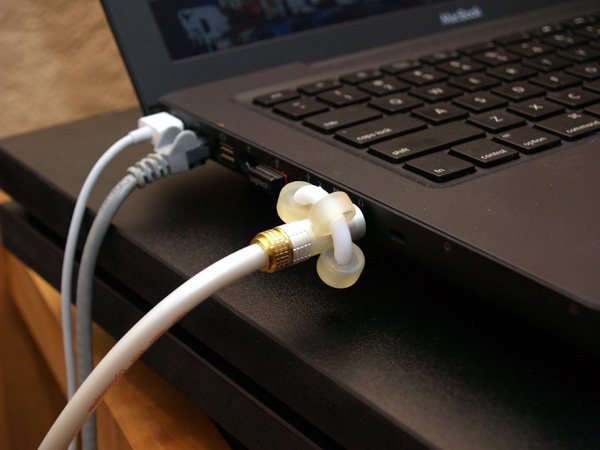
On a side note, the shelf/support from AudiAv uses several specific layers to address EMI/RFI. These materials are tested and chosen for their ability to mitigate the effects of EMI/RFI. All I can say is that prior to the shelf, while the computer rig sounded fine, it did have a slight glare or presence that was sort of obvious… things sounded good, just not great; a tad thin and grainy—too mid-rangy …not enough warmth. With the shelf under the Mac Book all I can say is wow… these sonic artifacts are gone and long forgotten. Warm, natural, smooth …very nice indeed. Seems that the Mac Book was no doubt emitting something that the Cary player did not like and with the shelf now acting as a shield, well …music now sounds very smooth and natural. I did try sheets of ERS paper to no affect. The shelf BIG affect… very positive! (I would like to note that in initially trying a Dell laptop prior to the Mac Book, the Dell clearly produced an audible hum from the system when placed near the Cary SLP-05 preamp. The Mac did not produce this hum; it was dead quiet, though both did cause similar sonic artifacts when placed above the Cary player.)
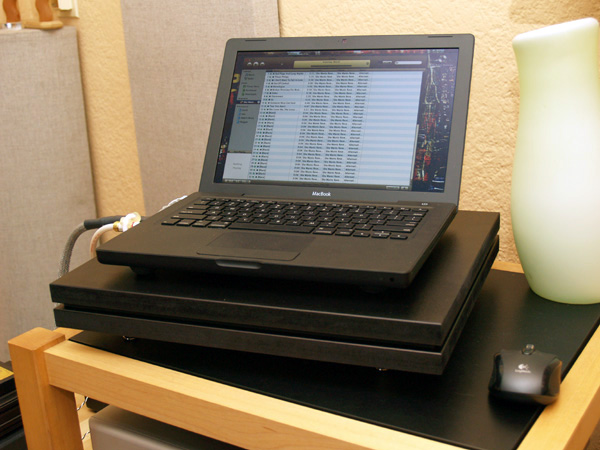
What is really cool is that the platform has a grounding connection on the rear to further attenuate the noise. Just connect a wire and attach that to an earth ground for even greater benefit. Mine is a custom order based on Audiav's Composite Signature Shelf…Nearly two inch (2") 50mm thick, hand-layered, quad HPL coated, dense, high-mass composite made up of cellulose, hemicellulose, and lignin in wood pulp blended with wax and resin polymers. The dense shelf composite has a lower resonance than glass, steel, acrylic, and solid woods. Patented center induction, ESD, Vibration, Thermal blocking layer(s). Internal layers of viscoelastics, asphalt, low mass composite closed cell nitrile reinforced neoprene bonded with patented layers of polychloroprene with rosin polymers... Highly recommended.
I prefer to use iTunes simply because the GUI is clean and simple, ripping is one touch, files are easily kept, etc… it works and does so in a way that meets my needs. I am using the computer set-up to play music on my terms… not to be the end all in high-end audio, but something that gets music out into the room—sort of a Clark radio station! And like I said, it sounds quite good as currently set up.
But still I was thinking …"Is ripping via iTunes the way to go?" So what did I try? I ripped the same song three different ways: 1) on my PC (custom Intel, Windows XP, Sony DVD/CDROM drives) via iTunes (set for Error Correction) and saved as Apple Lossless, 2) on my PC via EAC (tweaked for optimum rips) and saved to a wav. file which was then converted to Apple Lossless via Max, and 3) on the Mac Book via iTunes (set for Error Correction) as Apple Lossless. This gave me four files of the same song…
1. Apple Lossless via PC
2. Wav. via PC/EAC (100% accuracy).
3. Wav. via PC/EAC (100% accuracy) and then converted to Apple Lossless via MAX on the Mac Book
4. Apple Lossless via Mac Book
Playing them back on the Mac Book (the files were all located on the NAS) showed that for the most part they sounded WAY too much alike to prefer one over the other. Carol felt that to some degree she did not like the Lossless file ripped from the PC as much as the other three and I would agree, though the differences were subtle at best. Meaning that iTunes does a credible job in ripping files—equal to that of EAC—and that the wav. file sounded the same as an Apple Lossless file (as it should since they are the same exact file) and well …why bother going to all the trouble if iTunes works? So for me at least this does not matter.
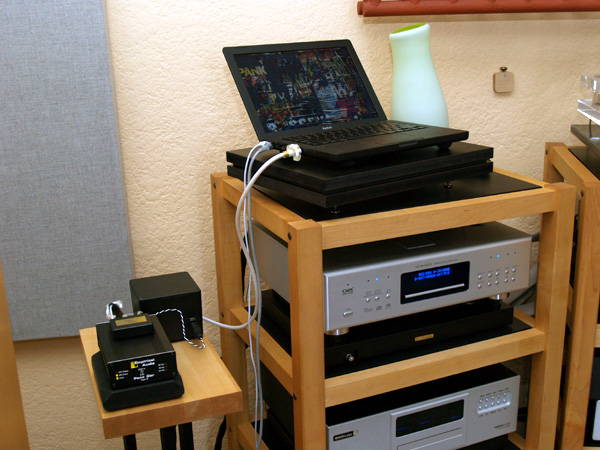

Even so, everyone seems to be hearing something different with different computers running different software, ripped differently, etc. And no doubt one should… different computers, different set-ups, different configurations, different tastes/preferences… get you different results. To a great extent I am starting to think that audible differences may be related more to how you have the WHOLE system set-up—the ability of your processor to process the computer being used and how it works with the software—can you say gestalt or synergy?), the quality of the AC or DC, quality of the cables and convertors, the position of the moon, etc—than anything else. So I guess one has to look at what they are doing and do it in a way that works for them and their set-up; seems that there is no clear path in computer audio …too many variables to deal with to make any absolute proclamations about what is the best way to get music from here to there. Then again, there is the pro idea …pay a premium to run pro software and rip by whatever from whatever because it will sound WAY better than how I am currently doing it. For me this simply means that if you can hear a difference, then knock yourself out (heck even the guys who write the stuff say that they all should sound the same …any differences are impossible if you understand code, which is all it is… code—it either works or it doesn't).
Right now it sounds really good; as good as the Cary or EMM spinning CDs …which was never what I was ever really after… but ended up with anyhow… so this is way cool. Perhaps it is all a matter of synergy… getting the whole set-up to work together …and right now I seem to have that working in spades ...but still more to come!
DH Labs www.silversonic.com
Locus Design http://www.locus-design.com
AudiAV www.audiav.com
Eugene HiFi www.eugenehifi.com
Hagerman Technology www.hagtech.com
Audio Magus www.audio-magus.com
Cryo-Parts www.cryo-parts.com
Empirical Audio www.empiricalaudio.com
Purist Audio Designs www.puristaudiodesign.com
Moon Audio www.moon-audio.com
Herbie's Audio Lab http://herbiesaudiolab.net
